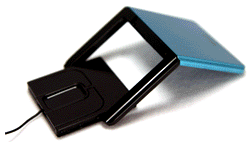Original URL: https://www.theregister.com/2007/07/05/review_2p_slim-mouse/
2P Slim-Mouse
Freakish or functional: is this credit card-sized mouse worth its cheese?
Posted in Personal Tech, 5th July 2007 10:47 GMT
Exclusive Review Manufacturer Power Positioning - aka 2P - describes the G4 Slim-Mouse as "the thinnest laptop mouse ever invented". That's not entirely true - Newton Peripherals' MoGo Bluetooth-connected rodent is just as thin as the Slim-Mouse and has been around for a little longer.

The Slim-Mouse also suffers in comparison with the MoGo because, unlike its rival, it's not a wireless product. What we can say is that its metal construction makes for what seems a much sturdier product, better able to survive life on the road. Helping it along in this respect is the leatherette wallet the Slim-Mouse comes boxed up with - alongside an A5-sized roll-up mouse mat.
But enough of the packaging. Out of the wallet, the Slim-Mouse looks like a PC Card peripheral of old - indeed, it's designed to able to fit inside a Type II PCMCIA slot, which it does, sort of. It went into the slot on our PC, but not smoothly and it still poked out a centimetre or so beyond the edge of the laptop. A bit like a Wi-Fi card.
Unopened, the Slim-Mouse is 9.4 x 5.3 x 0.5cm. The top half holds the business end - a small unit that has the optical pick-up, buttons and, in place of a scrollwheel, a trackpad - fitted between a two-tine fork. The very thin USB cable fits into a groove running into the bottom half of the mouse, which contains a spindle for the cable and the USB connector, itself just thick enough to sit inside the host PC's USB port.
With the USB connector in place at the centre of the spindle it's easy to turn it with your thumb and unpack the cable - and retract it when you're done. With the cable out, you push the optical unit a little way out to begin the Chinese Puzzle-like way you prepare the mouse for use.
The two halves of the rodent are separated by pivot cut at angle so that when the two halves are turned you end up with a V shape. With the V inverted - point upwards - you turn the optical unit so the LED is facing down, ready for use. Plug the USB cable in and you're away.
The tines of fork terminate in two spring-loaded bearings, one on either side. These run down tracks in the optical unit allowing it to be extended. Four indentations on each side lock the bearings in place so the buttons aren't constantly sliding about under your fingers.
That's the theory, at least. We found the arrangement initially too loose to work effectively and the optical unit kept falling off when fully extended. Pushing the prongs together a little helped tremedously, so there's another advantage to metal: unlike plastic, it bends.
Even so, the Slim-Mouse doesn't fit together with a James Bond gagdet quick click-click-click-and-you're-done motion, so it's going to be hard to look cool assembling one of these in front of chums, business colleagues and other folk you want to impress.
You'll need to make sure the optical unit is positioned for your finger size, but once you've got it right, the Slim-Mouse is surprisingly comfortable to use, given it doesn't have a single curve on it. The metal construction gives it a little weight to push against. 'Ergonomic' is an easy word to toss around, and 2P does so with abandon. We're not sure it really applies here, but then most small notebook mice, even more curvacious ones than this, aren't as comfortable as a big, palm-filling Logitech MX1000, for example.

The central scroll panel's sensitivity can be adjusted using the host's standard mouse control software. The buttons don't have much in the way of movement, but then neither do most mice on the market, and as long as you've placed the optical unit correctly, they're comfortable to use.
The mouse feels well engineered and while we're sure that, if you push hard enough, you can break the central hinge joint, it's not going to snap easily.
Our main concern was the optical pick up, which worked a treat on the bundled mini mouse mat, but suffered badly on our wooden desktop - not a problem we've experience with any other optical mouse. The Beech surface caused the unit to mis-read movement leading to very jerky tracking. Weird desk surface incompatibilities can occur with any optical mouse you buy, of course, and at least the Slim-Mouse comes with a mousemat.
Our other worry was the USB cable, which is only fractionally more than a millimetre in diameter. How securely it's anchored at the USB connector and mouse ends only time will tell, but our gut feeling is that it'll need careful handling to avoid breaking the wire within. We found it was particularly easy to knot, without even really trying.
2P wants €52/$70 (£35) for the Slim-Mouse, which you can buy direct from the company's website. That's around 15 of your hard-earned less expensive than the Mogo BT, but then you don't get wireless connectivity. You can get plenty of much cheaper optical and non-optical mice from the likes of Logitech that will work just as well as the Slim-Mouse, if not better. When they're all going to get shoved in your backpack or briefcase, you have to ask how much extra you really want to pay for an unusual look and tidy-away completeness.
Verdict
2P's Slim-Mouse is an engineering marvel that folds from an iPod Nano-sized slice into an eminently usable optical input device. Its clever construction could only be improved by adding wireless. Yet do you really have so little space you haven't room for a standard-sized mouse? We suspect not, leaving the Slim-Mouse more a design curiosity than a must-have.